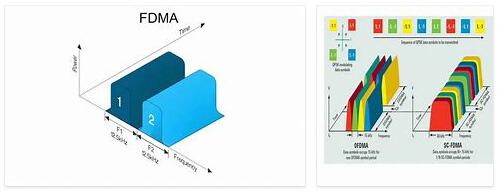
FDMA. Frequency Division Multiple Access (FDMA according to Abbreviationfinder.org) is a multiplexing technique used in multiple communication protocols, both digital and analog, mainly radio frequency, and among them in mobile phones in GSM networks.
In FDMA, access to the medium is done by dividing the available spectrum into channels, which correspond to different frequency ranges, assigning these channels to the different users and communications to be carried out, without interfering with each other. Users can share access to these different channels by different methods such as TDMA, CDMA or SDMA, these protocols being used interchangeably at different levels of the OSI model.
In some systems, such as GSM, the FDMA is complemented with a channel change mechanism according to the needs of the network, known in English as frequency hopping or “frequency hopping”. Its first appearance in mobile telephony was in First Generation telecommunications equipment (1980s), being of low transmission quality and poor security. The maximum data transfer rate was 240 baud.
Characteristics
- Very experienced and easy to implement technology.
- Rigid resource management and unsuitable for variable traffic flows.
- Requires antenna duplexer for duplex transmission.
- Individual channels are assigned to each user.
- Channels are assigned according to demand.
- Typically FDMA is combined with FDD multiplexing
Frequency division multiplexing
Frequency Division Multiplexing (FDM) or Frequency Division Multiplexing (FDM) is a type of multiplexing generally used in analog transmission systems. The way it works is as follows: each source of several that originally occupied the same frequency spectrum is converted to a different band of frequencies, and it is transmitted simultaneously by a single transmission medium. Thus many relatively narrowband channels can be transmitted over a single broadband transmission system. FDM is an analogous multiplexing scheme; the information that enters an FDM system is analog and remains analog throughout its transmission. An example of FDM is the commercial AM band, which occupies a frequency spectrum from 535 to 1605 kHz. If the audio of each station were transmitted with the original frequency spectrum, it would be impossible to separate one station from the others. Instead, each station amplitude modulates a different carrier frequency, and produces a 10KHz dual-sideband signal. There are many applications of FDM, for example, commercial FM and television stations, as well as high volume telecommunications systems. Within any of the commercial transmission bands, the transmissions of each station are independent of the others. A variant of MDF is used in optical fiber, where signals, which can be analog or digital, are multiplexed and transmitted by optical carriers of different wavelengths, giving rise to the so-called wavelength division multiplexing, o WDM from English Wavelength Division Multiplexing. The following image represents, in a highly schematic way, a frequency division multiplexer-demultiplexer set for three channels, each with the typical bandwidth of the analog telephone channel (0.3 to 3.4 kHz).
In this image, you can see how the signal from each of the channels modulates a different carrier, generated by its corresponding oscillator (O-1 to O-3). The modulation products are then filtered through band-pass filters, to select the appropriate sideband. In the case of the figure, the lower side band is selected. Finally, the outputs of the three filters (F-1 to F-3) are combined and sent to the transmission medium, which, in this example, must have a pass band between at least 8.6 and 19, 7 kHz. At the far end, the demultiplexer performs the inverse function. Thus, through filters F-4 to F-6, demodulators D-1 to D-3 (whose carrier is obtained from oscillators O-4 to O-6) and finally through low-pass filters F-7 to F-9, which select the lower side band, frequency band 0.3 to 3.4 kHz.